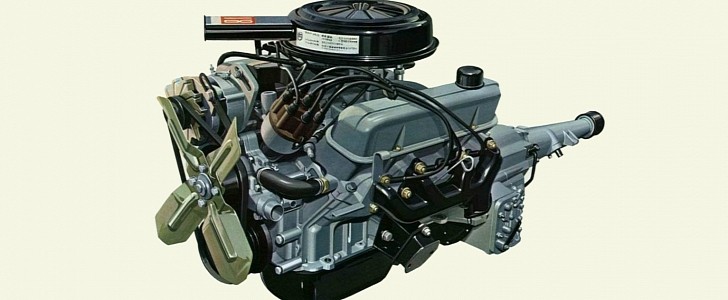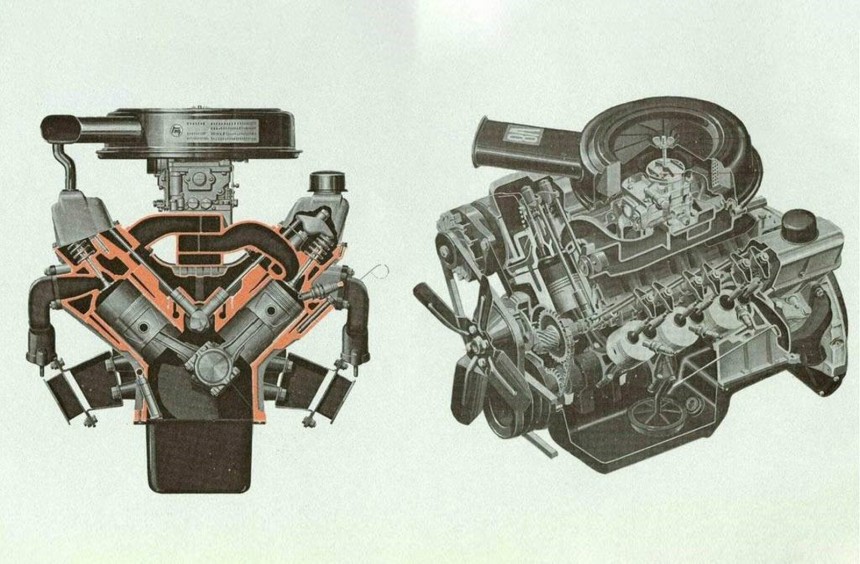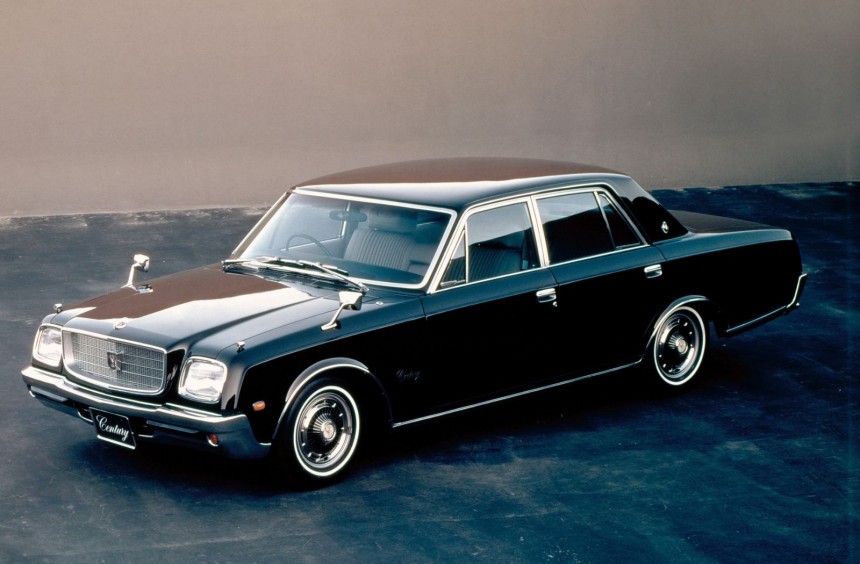The 1960s saw the revival of Chrysler’s famed HEMI engine in the shape of a gargantuan 426-ci (7.0-liter) developed for NASCAR dominance. Across the Pacific, Toyota introduced its first series-production V8 and just like the famous Elephant, it featured hemispherical combustion chambers.
Often associated with Chrysler’s powerplants, this design dates back to the early 1900s when several engineers discovered that hemispherical combustion chambers worked wonders for the unit’s thermal efficiency. By the late 1950s, many carmakers were employing it in various configurations. In Italy, there were Lancia’s V4 and V6 engines, as well as Alfa Romeo’s twin-cam “Bialbero.” In the UK, Jaguar’s new XK straight-six had them, while in the U.S., the Chrysler Corporation launched its first HEMI, a V8 dubbed FirePower.
A decade later, a new engine with hemispherical chambers was born in Japan. While the American manufacturer ended production of the FirePower and was working on a brand-new, race HEMI, Toyota was developing an upscale four-door sedan that could challenge the full-sized American cars in the Japanese market. At the time, these kinds of vehicles were used by wealthy businessmen with a passion for rumbling V8s, so to convince them to buy a Toyota instead, the company needed its own eight-cylinder.
Sourcing an American motor was out of the question since the main goal was to create an all-Japanese car, but the engineers had zero experience with V-shaped, eight-cylinders. A team of Toyota’s brightest talent was assembled, and folklore has it that numerous U.S.-build V8s were disassembled and extensively studied.
After agreeing on a final design, the engineers enlisted the help of Yamaha to create the block and cylinder heads. Unlike Chrysler’s FirePower and 426, both of which were built around a cast-iron block, Yamaha’s experts created a lighter, all-aluminum unit.
Codenamed V, the engine displaced 2.6 liters (158.6 ci), had a bore and stroke of 78 mm × 68 mm (3.07 in. × 2.68 in.), and a compression ratio of 9:0.1. The cylinder heads featured hemispherical chambers with a spark plug in the middle and two valves per cylinder. Each one was operated via rockers and pushrods by a single, chain-driven camshaft that sat inside the block, on top of the forged crankshaft.
Smaller than any of Chrysler’s HEMIs, Toyota’s first V8 was also less powerful. It could only make 114 hp and 145 lb-ft (196 Nm) of torque. Since it was lighter and conceived exclusively for a luxurious sedan, the output was considered adequate.
Mated to a three-speed automatic, the V at the heart of the Crown Eight was unveiled at the 1963 Tokyo Motor Show and went on sale a year later. It was built until 1976 when Toyota replaced the Crown Eight with a new model, the Century.
A marvel of Japanese engineering at the time, this new flagship came with an updated Hemi. Aiming for more power and reliability, the engineers increased the piston stroke to 78 mm (3.07 in), making the new 3V a square engine. It was now a 3.0-liter (183 cu-in.) capable of delivering 148 hp and 173 lb-ft (235 Nm) of torque. Early versions came with a mechanical distributor but starting with 1967, it was replaced with an electronic ignition system.
The first generation Century was continually improved for the next three decades, and so was its V8. In 1973, the 3V was discontinued, and the third iteration dubbed 4V took its place. Its cylinder bores were enlarged to 83 mm (3.27 in.), increasing the displacement to 3.4 liters (247.4 ci). These modifications increased its peak output to 177 hp and 205 lb-ft (278 Nm) of torque. The 4V was built until 1983, when the last, biggest, and most powerful version was released.
Codenamed 5V, the 4.0-liter (244 ci.) V8 had a bore and stroke of 83 mm × 78 mm (3.27 in. × 3.07 in.). Unlike its predecessors, it came with overhead valves and electronic fuel injection. To comply with emission regulations, it was fitted with a catalytic converter, a device that was also fitted on late 4Vs. The 5V was rated at 188 hp and 239 lb-ft (324 Nm) of torque, nearly three times less than Chrysler’s 426.
The carmaker ended the production of its first V8 in 1997 when the Century got a major redesign. The second generation debuted in April, and it was powered by the first (and only) V12 mass-produced in Japan. Its indirect successor, the company's second V8, came in 1989 under the hood of the Lexus LS 400.
Although the Toyota Hemi was nowhere near the American versions in terms of power, it was renowned for its reliability, and that’s exactly the reason why the manufacturer intentionally limited each version’s output.
Since it was only available on the Crown Eight and Century, two models exclusively sold in Japan, this engine is rare. Moreover, local enthusiasts who love to tune Toyota motors choose to work on four- and six-cylinders, so the true potential of this V8 is largely untapped. In the video below posted on YouTube by Rick Brenchley, you can see a hotrod with what appears to be a 5V equipped with a blower. Unfortunately, we found no details about other modifications or performance.
A decade later, a new engine with hemispherical chambers was born in Japan. While the American manufacturer ended production of the FirePower and was working on a brand-new, race HEMI, Toyota was developing an upscale four-door sedan that could challenge the full-sized American cars in the Japanese market. At the time, these kinds of vehicles were used by wealthy businessmen with a passion for rumbling V8s, so to convince them to buy a Toyota instead, the company needed its own eight-cylinder.
Sourcing an American motor was out of the question since the main goal was to create an all-Japanese car, but the engineers had zero experience with V-shaped, eight-cylinders. A team of Toyota’s brightest talent was assembled, and folklore has it that numerous U.S.-build V8s were disassembled and extensively studied.
After agreeing on a final design, the engineers enlisted the help of Yamaha to create the block and cylinder heads. Unlike Chrysler’s FirePower and 426, both of which were built around a cast-iron block, Yamaha’s experts created a lighter, all-aluminum unit.
Smaller than any of Chrysler’s HEMIs, Toyota’s first V8 was also less powerful. It could only make 114 hp and 145 lb-ft (196 Nm) of torque. Since it was lighter and conceived exclusively for a luxurious sedan, the output was considered adequate.
Mated to a three-speed automatic, the V at the heart of the Crown Eight was unveiled at the 1963 Tokyo Motor Show and went on sale a year later. It was built until 1976 when Toyota replaced the Crown Eight with a new model, the Century.
A marvel of Japanese engineering at the time, this new flagship came with an updated Hemi. Aiming for more power and reliability, the engineers increased the piston stroke to 78 mm (3.07 in), making the new 3V a square engine. It was now a 3.0-liter (183 cu-in.) capable of delivering 148 hp and 173 lb-ft (235 Nm) of torque. Early versions came with a mechanical distributor but starting with 1967, it was replaced with an electronic ignition system.
Codenamed 5V, the 4.0-liter (244 ci.) V8 had a bore and stroke of 83 mm × 78 mm (3.27 in. × 3.07 in.). Unlike its predecessors, it came with overhead valves and electronic fuel injection. To comply with emission regulations, it was fitted with a catalytic converter, a device that was also fitted on late 4Vs. The 5V was rated at 188 hp and 239 lb-ft (324 Nm) of torque, nearly three times less than Chrysler’s 426.
The carmaker ended the production of its first V8 in 1997 when the Century got a major redesign. The second generation debuted in April, and it was powered by the first (and only) V12 mass-produced in Japan. Its indirect successor, the company's second V8, came in 1989 under the hood of the Lexus LS 400.
Although the Toyota Hemi was nowhere near the American versions in terms of power, it was renowned for its reliability, and that’s exactly the reason why the manufacturer intentionally limited each version’s output.
Since it was only available on the Crown Eight and Century, two models exclusively sold in Japan, this engine is rare. Moreover, local enthusiasts who love to tune Toyota motors choose to work on four- and six-cylinders, so the true potential of this V8 is largely untapped. In the video below posted on YouTube by Rick Brenchley, you can see a hotrod with what appears to be a 5V equipped with a blower. Unfortunately, we found no details about other modifications or performance.











